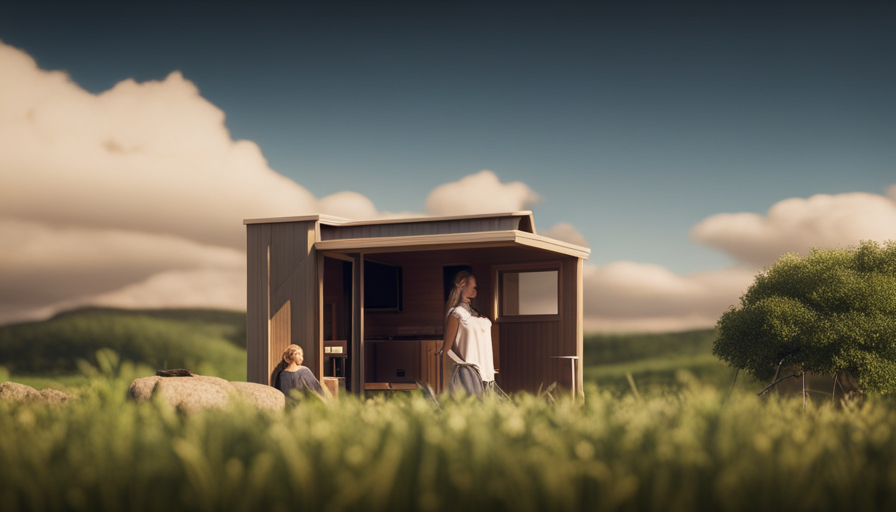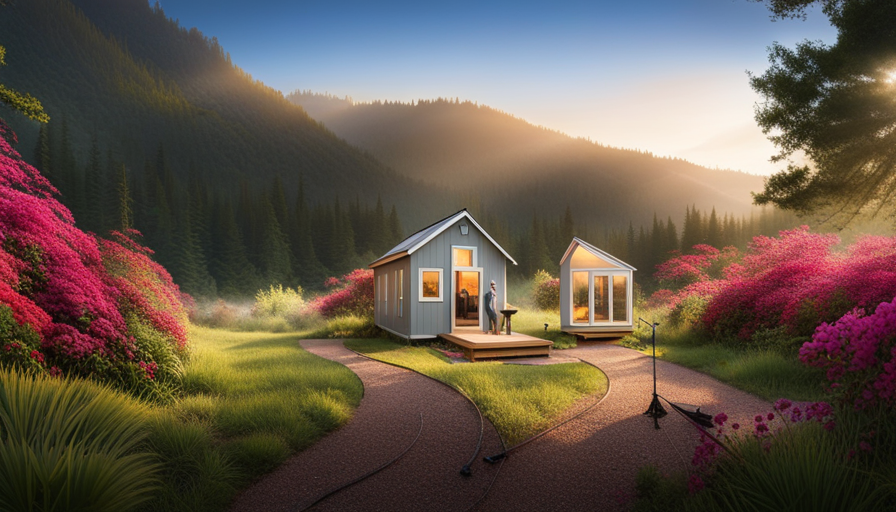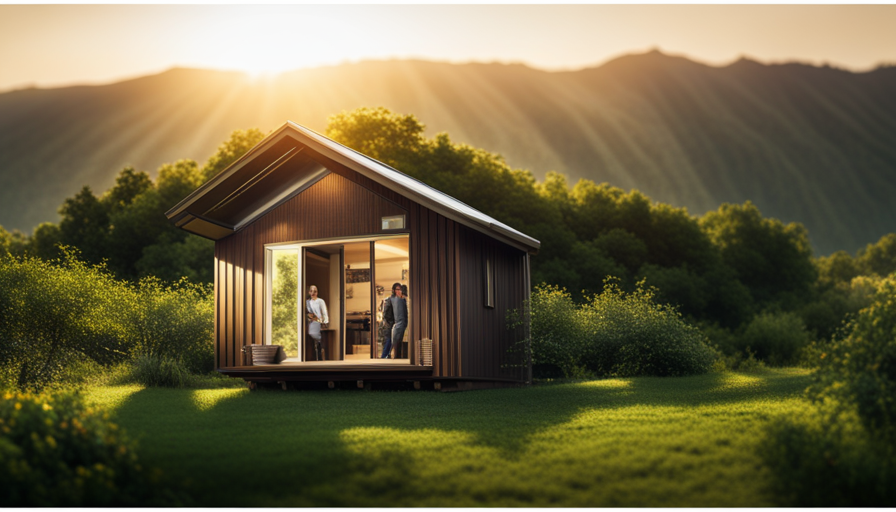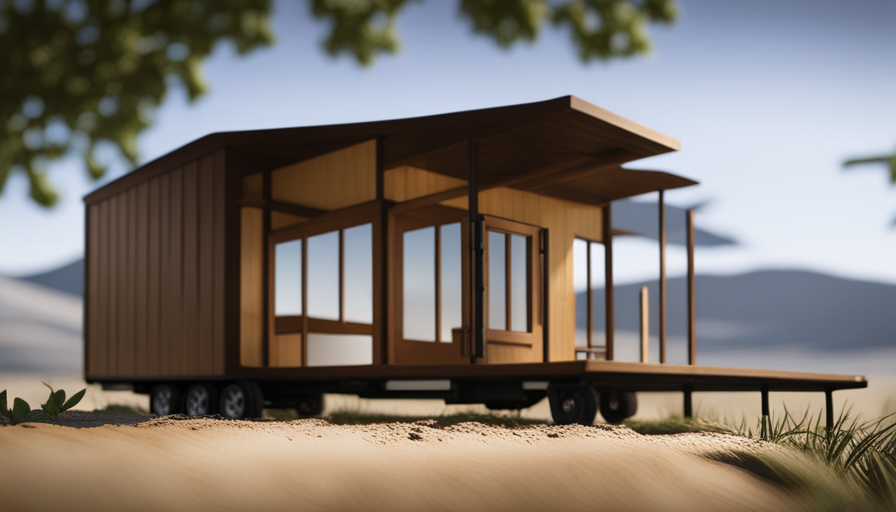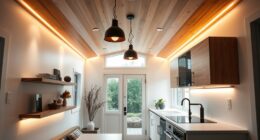Fortunately, as I embarked on the journey of building a tiny house, I happened to come across a crucial question: what is the maximum length my tiny house can be? Understanding the regulations and guidelines for tiny houses may appear overwhelming and complex, but fear not, as I have delved deep into this topic to provide you with the detailed, precise, and comprehensive information needed.
Whether you prefer a tiny house on wheels or a foundation-built structure, understanding the maximum length limits is essential. But don’t fret about limited space – I’ll also explore creative design solutions that optimize every inch. And if you’re considering working with a professional builder, I’ll guide you through the process.
Financing and insurance can also be daunting, but I’ll break it down for you. Plus, I’ll reveal the benefits of joining a tiny house community and share tips on making your tiny house feel like home.
So, buckle up and let’s unravel the mysteries of tiny house length regulations together.
Key Takeaways
- Maximum length limits for tiny houses on foundations range from 20 to 30 feet.
- Maximum length limits for tiny houses on wheels are typically 13.5 to 14 feet for safe transportation on public roads.
- Transportation and road regulations for tiny houses vary by state, including weight limits and size limitations for towing and parking.
- Zoning restrictions dictate where you can park or build your tiny house, so it’s important to consider local regulations when determining the length of your tiny house.
Understanding Tiny House Regulations
Did you know that understanding tiny house regulations is crucial when determining how long your tiny house can be?
Tiny house zoning restrictions and building codes for tiny houses vary by location, so it’s important to research the specific regulations in your area. Zoning restrictions typically dictate where you can park or build your tiny house, while building codes ensure the safety and structural integrity of the house.
When it comes to tiny house zoning restrictions, some areas classify tiny houses as accessory dwelling units (ADUs), allowing them to be parked or built on residential lots. However, other areas may only permit tiny houses in designated tiny house communities or campgrounds. It’s important to check with your local planning department or zoning board to understand the specific regulations in your area.
Building codes for tiny houses also vary by jurisdiction, but they generally require compliance with certain safety standards. These standards may include requirements for electrical systems, plumbing, insulation, and fire safety. Building codes aim to ensure that your tiny house meets minimum safety standards and is habitable.
Understanding these regulations is essential before determining the maximum length limits for your tiny house. By familiarizing yourself with the specific zoning restrictions and building codes in your area, you can ensure that your tiny house meets all the necessary requirements.
Now let’s move on to discussing the maximum length limits for tiny houses.
Maximum Length Limits for Tiny Houses
Can you believe that there’s actually a maximum limit to how far your tiny dream can stretch? When it comes to tiny house zoning and building codes, there are specific regulations in place that dictate the maximum length of a tiny house.
These regulations vary depending on the location and jurisdiction, so it’s important to do your research before starting your tiny house project.
In general, most areas have a maximum length limit for tiny houses on foundations, which typically ranges from 20 to 30 feet. This limit is in place to ensure that the tiny house remains within the parameters of a ‘small dwelling’ and doesn’t encroach on the space requirements for larger homes. Additionally, the maximum length limit helps to maintain the aesthetic and character of the surrounding neighborhood.
Considerations for on-wheels tiny houses, on the other hand, can be slightly different. Many states have adopted the guidelines set forth by the National Highway Traffic Safety Administration (NHTSA) for tiny houses on wheels. These guidelines typically limit the maximum length to 13.5 to 14 feet for safe transportation on public roads.
It’s important to keep these regulations in mind when designing and building your tiny house to ensure compliance with local zoning and building codes.
Now, let’s move on to the next section and discuss considerations for on-wheels tiny houses.
Considerations for On-Wheels Tiny Houses
When considering an on-wheels tiny house, it’s important to be aware of transportation and road regulations. This includes understanding the maximum size limitations for towing and parking.
It’s crucial to adhere to these regulations to ensure safe and legal transportation of your tiny house.
Transportation and Road Regulations
While driving on the open road, it’s important to consider the transportation and road regulations that may dictate the length of your tiny house. Understanding transportation restrictions and weight limits is crucial to ensure a safe and legal journey. Here are some key points to keep in mind:
-
Each state has its own transportation restrictions for oversize loads, which may include specific rules regarding the maximum length allowed for towing a tiny house.
-
Weight limits also play a significant role in determining the length of your tiny house, as exceeding the maximum weight limit can result in fines or even impoundment.
-
It’s essential to research and adhere to the road regulations in each state you plan to travel through to avoid any legal issues.
-
Consulting with a professional tiny house builder or transportation specialist can help you navigate through the various rules and regulations effectively.
Considering these transportation and road regulations will provide you with a smooth and trouble-free journey.
Next, we will explore the size limitations for towing and parking without compromising safety and legality.
Size Limitations for Towing and Parking
To ensure a safe and legal journey, you must be aware of the size limitations for towing and parking your compact dwelling on wheels.
When it comes to towing, there are regulations in place that dictate the maximum width, height, and length of the tiny house. These limitations vary from state to state, so it’s crucial to check with the Department of Transportation in your area.
Additionally, parking your tiny house also has its own set of restrictions. Zoning regulations and building codes play a significant role in determining where you can park your tiny house. Some areas may have specific requirements for setbacks, minimum lot sizes, or even prohibit parking altogether. It’s essential to research and comply with these regulations to avoid any legal issues.
Moving on to the next section about foundation-built tiny houses…
Foundation-Built Tiny Houses
You can build your foundation-built tiny house to any length you desire! Unlike tiny houses on wheels that have size limitations for towing and parking, foundation-built tiny houses don’t have these restrictions.
However, it’s important to consider zoning restrictions in your area before constructing a foundation-built tiny house.
When it comes to designing your foundation-built tiny house, here are three important factors to consider:
-
Building codes: Make sure to comply with all local building codes and regulations. This includes adhering to minimum square footage requirements and setback distances from property lines.
-
Structural integrity: As your tiny house will be permanently fixed to the ground, it’s crucial to ensure it’s structurally sound. This may involve working with a structural engineer to determine the appropriate foundation and framing for your desired length.
-
Utilities and services: Consider how your tiny house will connect to utilities such as water, electricity, and sewage. Plan the layout accordingly to ensure efficient and safe access to these services.
By carefully considering these factors, you can design a foundation-built tiny house that meets your specific needs and desires within the limitations of zoning restrictions.
In the subsequent section about creative design solutions for limited space, we’ll explore innovative ways to maximize the functionality of your tiny house.
Creative Design Solutions for Limited Space
Discover the endless possibilities of designing your compact living space to maximize functionality and ignite your imagination. When it comes to limited space, storage solutions and multi-purpose furniture are key elements in creating a well-designed tiny house.
With clever design strategies, you can create innovative storage solutions that make the most of every inch of your home. Utilize vertical space by incorporating built-in shelving units and overhead storage compartments. Install hidden storage compartments beneath staircases or within furniture pieces, allowing you to store items out of sight but easily accessible when needed.
In addition to efficient storage solutions, multi-purpose furniture is another essential element in maximizing space. Consider investing in furniture that can serve multiple functions, such as a sofa that can transform into a bed or a dining table that can double as a workspace. Folding chairs and collapsible tables are also great options for saving space when not in use. By incorporating these versatile furniture pieces, you can easily adapt your space to meet your changing needs.
With the right design choices, your tiny house can offer all the functionality and comfort of a larger home. From clever storage solutions to multi-purpose furniture, every aspect of your compact living space can be optimized. These design strategies not only make the most of limited space but also enhance the overall livability of your tiny house.
Transitioning into the subsequent section about the benefits of a smaller tiny house, it becomes evident that a well-designed compact living space can offer a multitude of advantages.
Benefits of a Smaller Tiny House
Experience the incredible advantages of living in a cozy, well-designed compact space that maximizes functionality and sparks creativity. Small space living offers a minimalist lifestyle that brings numerous benefits.
Here are three key advantages of living in a smaller tiny house:
-
Efficient Use of Space: A smaller tiny house forces you to be creative with your space. Every square inch matters, so you’ll find innovative storage solutions and multifunctional furniture that optimize every corner. From hidden drawers under staircases to collapsible tables and beds, you’ll be amazed at how much functionality can be packed into a small space.
-
Lower Costs: A smaller tiny house means lower costs in terms of both construction and maintenance. Building a smaller structure requires fewer materials, reducing the overall expense. In addition, the reduced square footage translates into lower utility bills and less money spent on furnishings and decor. With less space to clean and maintain, you’ll have more time and money for activities you enjoy.
-
Environmental Impact: Living in a smaller tiny house is an environmentally conscious choice. With a smaller footprint, you’ll consume fewer resources and produce less waste. Additionally, a smaller space requires less energy for heating and cooling, reducing your carbon footprint. By embracing a minimalist lifestyle, you’ll contribute to a more sustainable future.
Transitioning into the next section about working with a professional tiny house builder, it is essential to understand the potential of optimizing a small space to suit your needs.
Working with a Professional Tiny House Builder
Imagine collaborating with a skilled tiny house builder who can turn your vision of a compact, functional dream home into a stunning reality. When working with professionals, you can benefit from their expertise and experience in designing and constructing tiny houses. They understand the unique challenges and complexities involved in building a small space that maximizes efficiency and functionality.
One advantage of working with a professional tiny house builder is their knowledge of local building codes and regulations. They can guide you through the process of obtaining the necessary building permits, ensuring that your tiny house meets all the legal requirements. This is crucial to avoid any potential legal issues or delays in the construction process.
Additionally, professional builders have access to a network of reliable suppliers and subcontractors, which ensures the quality and timely completion of your tiny house. They can help you select the right materials and finishes that are not only aesthetically pleasing but also durable and suitable for the limited space.
Collaborating with a professional tiny house builder is essential for a successful and hassle-free construction process. Their expertise in navigating building permits and their access to a reliable network of suppliers and subcontractors are invaluable. With their guidance, you can confidently move forward with the construction of your dream tiny house.
Now, let’s explore the next step: financing and insurance for tiny houses.
Financing and Insurance for Tiny Houses
One crucial aspect of building a compact dream home is securing financing and insurance. When it comes to financing options for tiny houses, there are a few routes you can take.
Firstly, you can explore personal loans from banks or credit unions. These loans typically have higher interest rates but offer flexibility in terms of repayment.
Another option is to seek out specialized tiny house lenders who understand the unique needs of this type of housing. They may offer more favorable terms and rates specifically tailored for tiny house financing.
Additionally, some individuals choose to use their savings or take out a home equity loan to fund their tiny house project.
In terms of insurance coverage, it’s important to find a policy that specifically covers tiny houses. Traditional homeowner’s insurance may not provide adequate coverage for these unique structures. Look for insurance providers that offer policies specifically designed for tiny houses, including coverage for theft, accidents, and natural disasters.
It’s also essential to consider liability coverage in case someone gets injured on your property.
Transitioning to the next section about joining tiny house communities, it’s important to consider the benefits of living in a community-oriented environment.
Joining Tiny House Communities
When it comes to financing and insurance for tiny houses, there are many options available to ensure that you can protect your investment and secure the necessary funds. However, once you’ve sorted out these financial aspects, the next step is to think about joining tiny house communities and finding affordable land to park your tiny house.
Joining a tiny house community can provide numerous benefits, such as a sense of belonging and a supportive network of like-minded individuals. These communities often offer shared amenities and resources, such as communal gardens, laundry facilities, and social spaces. Additionally, being part of a community can help you navigate the challenges that come with living in a tiny house, as you can learn from others’ experiences and gain valuable insights.
When it comes to finding affordable land, there are several strategies you can employ. One option is to connect with local landowners who may be willing to rent or sell a portion of their property for your tiny house. Another option is to explore rural areas where land prices may be lower, or consider joining an existing tiny house community that already has established land arrangements.
Transitioning into the subsequent section about making your tiny house a home, it’s important to consider the interior design and personalization of your space.
Making Your Tiny House a Home
To truly transform your compact abode into a cozy haven, start by infusing your unique personality and style into every nook and cranny. Making your tiny house cozy involves personalizing it to reflect your tastes and preferences. Here are some key ways to achieve this:
-
Color Palette: Choose a color scheme that resonates with you. Consider using warm tones like earthy browns or soothing blues to create a calming atmosphere.
-
Furniture Selection: Opt for furniture that is both functional and comfortable. Look for multi-purpose pieces like a sofa that can double as a bed or a table with built-in storage.
-
Lighting: Lighting plays a crucial role in setting the mood. Consider installing dimmable lights to create a cozy ambiance, and add task lighting in areas where you need it most.
-
Textiles and Decor: Soften the space with cozy textiles such as plush rugs, fluffy pillows, and warm blankets. Decorate with personal mementos, artwork, and plants to add character.
-
Organization: Keep your tiny house clutter-free by maximizing storage space. Utilize smart storage solutions like under-bed drawers or built-in shelving to maintain a tidy and inviting environment.
Remember, the key to making your tiny house a home is to infuse it with your personal touch. By following these tips, you can create a warm and inviting space that reflects your unique style and makes you feel right at home.
Frequently Asked Questions
Can I build a tiny house longer than the maximum length limit if I obtain special permits?
Yes, it’s possible to build a tiny house longer than the maximum length limit if you obtain special permits. These permits allow for exceptions to be made for specific cases, such as when there’s a need for additional space or if certain design requirements are met.
However, it’s important to note that the process of obtaining special permits can vary depending on local regulations and authorities.
Are there any restrictions on the height and width of a tiny house?
There are height restrictions and width regulations that apply to tiny houses. These restrictions vary depending on the specific location and local building codes. It’s important to consult with local authorities or zoning departments to determine the specific requirements for your area.
These regulations ensure that the tiny house doesn’t exceed certain height and width limits to maintain safety standards and compatibility with existing infrastructure.
Are there any specific regulations for tiny houses built on a foundation in flood-prone areas?
In flood-prone areas, specific regulations exist for tiny houses built on a foundation. These regulations aim to ensure the safety and resilience of the structures. When constructing a tiny house in such areas, it’s crucial to adhere to guidelines set by local authorities.
These regulations typically outline requirements for elevation, flood-resistant materials, and proper anchoring methods. By following these specific regulations, the tiny house can be designed to withstand flooding and minimize potential damage.
What are the most common challenges that people face when designing and living in a tiny house?
Designing and living in a tiny house comes with its own set of challenges, akin to navigating a complex maze.
Space optimization is crucial, as every square inch counts. Challenges faced include finding creative storage solutions, maximizing functionality in a limited area, and ensuring efficient use of utilities.
Additionally, careful planning is required to ensure that the layout and design of the tiny house meet the needs and preferences of the dweller, while maintaining a sense of comfort and practicality.
How can I ensure that my tiny house is energy-efficient and sustainable?
To ensure that my tiny house is energy-efficient and sustainable, I’ll focus on incorporating energy-efficient appliances and utilizing sustainable materials. I’ll choose appliances like LED lighting and energy star-rated appliances to reduce electricity consumption. For construction, I’ll use sustainable materials such as bamboo flooring and reclaimed wood to minimize environmental impact. To enhance energy efficiency, I’ll also prioritize proper insulation and solar panels, reducing reliance on traditional power sources.
Conclusion
In conclusion, navigating the world of tiny house regulations requires careful consideration and planning. Whether you choose a tiny house on wheels or a foundation-built structure, understanding the maximum length limits is crucial.
Creative design solutions and working with a professional builder can help optimize limited space. Financing and insurance options should also be explored.
Lastly, joining tiny house communities can provide a sense of belonging and support. Just like a tiny house, this journey is a delicate dance, where each step brings us closer to making our tiny house a home.
Hi, I’m Emma. I’m the Editor in Chief of Tiny House 43, a blog all about tiny houses. While tree houses are often associated with childhood, they can be the perfect adult retreat. They offer a cozy space to relax and unwind, surrounded by nature. And since they’re typically built on stilts or raised platforms, they offer stunning views that traditional homes simply can’t match. If you’re looking for a unique and romantic getaway, a tree house tiny house might just be the perfect option.
